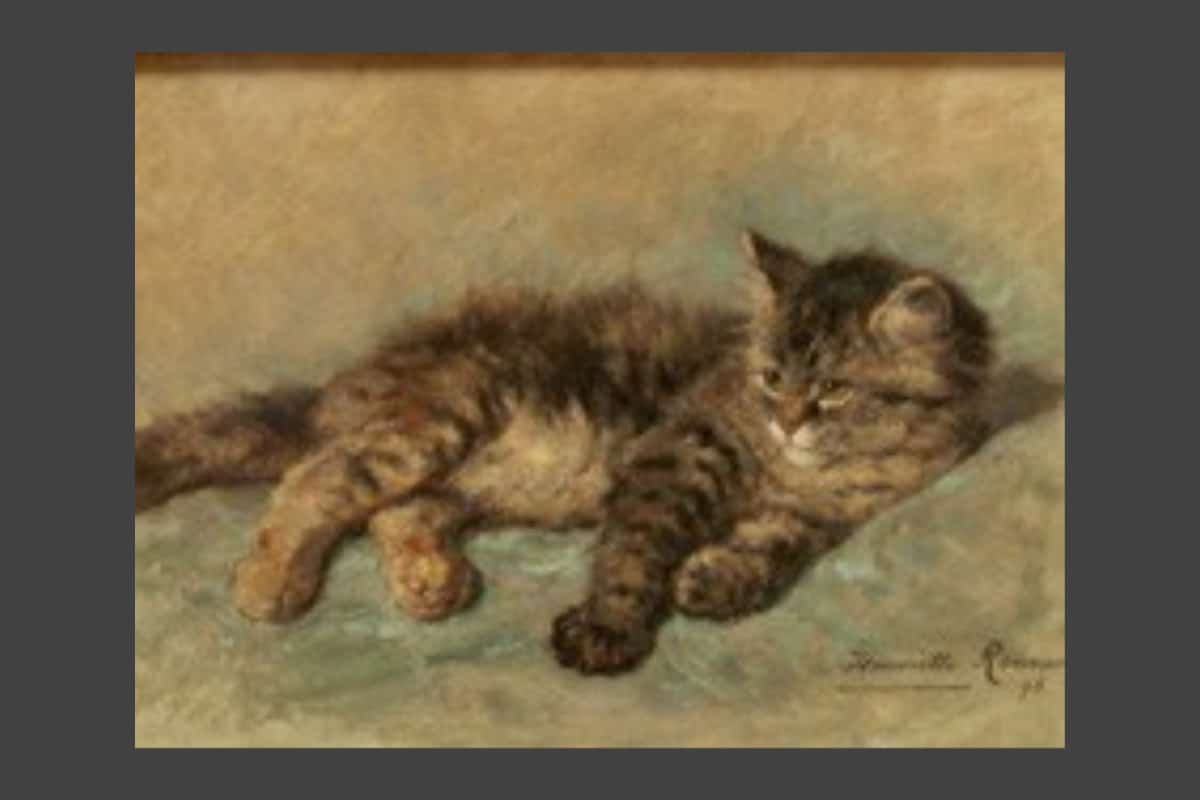A fantastic woman artist that many may not know about is the Dutch artist Henriette Ronner-Knip. She is famous for her many beautiful paintings of dogs and cats.
Henriette Ronner-Knip came from a family of artists. She became in charge of the family’s finances and other legal obligations at an early age, so she started to paint. She sold her first painting at the age of 15-year-old. Later, when she was married, Her husband became her manager, and Henriette continued to paint. She is famous for her many beautiful paintings of cats and dogs. She chooses to paint dogs and cats as subject matter because, during the Victorian era, having a pet in your household was popular.
Table of Contents
- Henriette Ronner Knip – Early Life
- Painting Dogs and Cats
- The Victorians Love for Dogs and Cats
- Frequently Asked Questions
- Frequently Asked Questions
- Related Questions
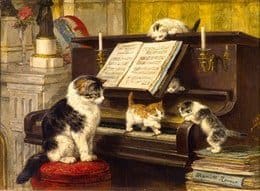
Henriette Ronner Knip – Early Life
Henriette was born in Amsterdam in 1821 into a family of artists. She received her very first painting lessons from her father, Josephus Augustus Knip. Her grandfather, Nicolas Frederick Knip was also an artist. So it can be said that she was indeed born into a family with a long history of painting and choosing art as their profession.
Her mother, Pauline Rifer de Courcelles, was also a painter. She painted a lot of birds. She was her father’s first wife, but it is said that her father was already living with his mistress, Cornelia van Leeuwen (1790-1848). Because of this, Cornelia is usually credited with being Henriette’s mother.
It can be said that Henriette did not have a typical upbringing for her time. Josephus was an art instructor, so they often moved to find work-giving art lessons. In 1823, her father became blind in one eye. In 1824 he finally divorced his first wife, Pauline, and he married Cornelia. By 1832 her father was completely blind.
In 1835, at the age of 14, Henriette was in charge of the family’s finances and other legal obligations, so she began to paint seriously to help the family bring in income. She sold her first painting at the age of 15 years old. Henriette had a lot of financial and other obligations placed upon her at a very young age. In 1840, the family settled in Berlicum, Holland.
Marriage and Move to Amsterdam
In 1848 Cornelia died, so Henriette moved to Amsterdam, where she continued to paint farm animals, forests, and other scenes from nature. She painted first in watercolors and then later changed to paint in oil paints. She became active in many artistic circles and organizations, such as the Arti et Amicitiae, a Dutch Artist Society founded in 1839.
In 1850 she married Feico Ronner, and they moved to Brussels. Feico was often ill and could not be regularly employed, so he became Henriette’s manager. But also once again, Henriette found herself as the main financial supporter of the family.
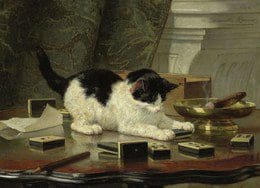
Painting Dogs and Cats
After her marriage to Feico, Henriette also narrowed her subject matter to paint almost entirely dogs and cats. We are not sure if we did this because she loved animals or saw an opportunity to provide the rich Victorians with paintings of the animals. But it would seem she must have loved animals as her paintings show a woman who understood them very well.
Later in life, Henriette had a house with a garden where she kept hunting dogs, cats, and a parrot that she would use as her models. To be an artist of animals, she had also to study them. She would study their behaviors and then make paper sculptures of the animals in various poses and positions. Then with the use of props, she would put them together with furniture and other fabrics.
She took the study of the animal subjects she painted very seriously. She constructed a specially built glass-fronted studio where her cats could freely run about, sleep, and get into trouble as most cats do. This would allow her to observe them and paint their behavior as she saw them. This is also one reason why, even today, her paintings appeal to so many people for their timeless ability to understand our pets’ nature, especially cats.
After the 1870s, at the age of 49, she painted some of her most important works. To put this into perspective, she would have been a professional painter then for over 35 years.
After this time period, some of her most famous paintings were of lapdogs, including one belonging to Maire Henriette of Austria and Princess Marie of Hohenzollern-Sigmarigen. She was also very famous for the long-haired cats she placed in bourgeois settings.
Besides painting what must have been full-time, Henriette was also a wife and mother of six children. Several of her children also became artists. Her son Alfred was a famous Belgian painter, graphic artist, and illustrator. Her daughter Alice specialized in still life paintings of fruit and flowers. Her daughter Emma painted some cats and other subjects.
Henriette died in 1909 at the age of 88 years old. She was a woman who was ahead of her time, as she was a full-time painter and the family’s breadwinner. She must have had an amazing family and work-life balance.
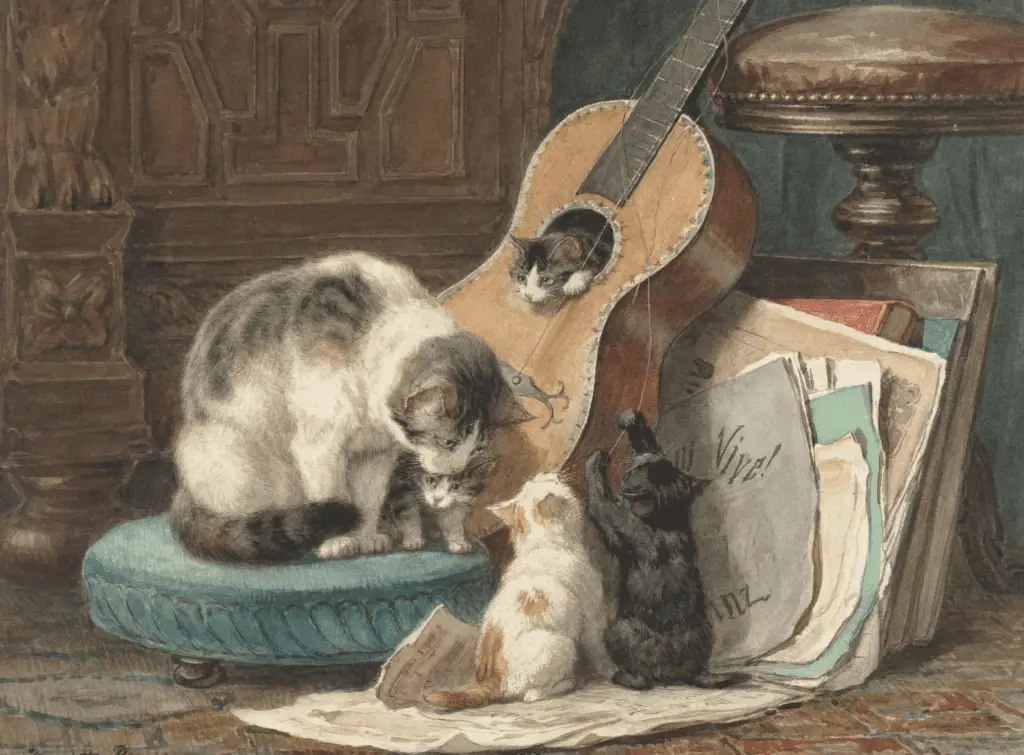
The Victorians Love for Dogs and Cats
One reason why Henriette painted so many dogs, cats, and other animals is that the Victorians had a great love for dogs, cats, and other pets. So it would be natural that many pets would also be shown in paintings, or a painting of your pet could be an essential part of the Victorian decor.
For those of us who are animal lovers, we have the Victorians to thank as they changed our attitude towards having domestic animals such as dogs and cats as pets. Jane Hamlett, professor of modern British history at Royal Holloway, University of London, and Professor Julie-Marie Strange at the University of Durham, have been leading a study on pets’ history, particularly in the Victorian Era. Professor Hamlett has said:
“We thought we would find that there has been an increase in people’s emotional investment in pets in recent times, but what we’ve actually found is that people in the early 19th century were also very emotionally invested in their animals. They just expressed that in a different way….They had a different cultural sense of what a pet should be.”
Jane Hamlett
In the late 18th and 19th Centuries, it became more culturally acceptable to have a pet like a cat or a dog. It was artists like Henriette that almost assigned a new moral value to animals. This is because she painted them in almost human poses. The cats on a piano feel like they are getting a piano lesson or cats around musical instruments
Victorians Became Interested in Home Life
One of the reasons for this is that people during the Victorian era began to be very interested in home life. They also saw pets as a way to help train and teach their children. Professor Hamlett continued to say:
“The Victorians were very interested in the home and domestic life, and bringing up children was seen as very important for creating the right kind of morality in society … And one of the things that children could do to develop morality was to keep a pet – so you get quite a lot of advice manuals from the mid-19th century onwards suggesting that children should keep pets to improve themselves and their moral qualities.”
JANE HAMLETT
Having a pet was just not limited to the rich. Many poor or working-class families would capture a wild bird like a blackbird and put it in cages hanging outside their windows. They would then feed the bird scraps from their table.
Pedigree Dogs Were Trendy During the Victorian Era
Pedigree dogs were trendy during the Victorian time as they were a sign of wealth (you could afford to keep a dog) and were known to have a lot of good Victorian cultural values as being loyal and courageous.
Rabbits were also popular as a boy could build a small rabbit hutch to keep the rabbits in and take care of them. The wealthy families would import wild parrots or monkeys from the territories and keep them as pets.
Cats were also popular but not as popular as some other animals. Many people also saw cats as a pet and as an animal to help keep the mice and vermin out of the house and other places.
Many Victorian painters painted cats as their main subject matter or placed cats in a part of their paintings. You can read our blog 15 Paintings Featuring Cats, My Top Picks by clicking here.
Pets started to become such an integrated part of Victorian life. Pet cemeteries were popular, as was the start to manufacture pet food and medicine produced specifically for animals.
When you look at the history of pets in the Victorian era, you can more fully understand why a painter like Henriette would concentrate on painting animals in scenes that seem almost human.
When you think about an artist who understood cats and dogs and other animals, you should think about Henriette Rooner-Knip and her uncanny way of painting the animals, especially cats, in positions and poses like no one else does. She was a woman painter whose artistic work is as important today as it was during her lifetime.
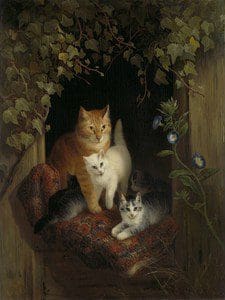
Frequently Asked Questions
Who was Henriette Ronner-Knip, and why is she famous?
Henriette Ronner-Knip was a Dutch artist born in 1821, known for her remarkable paintings of cats and dogs. Her fame stems from her ability to capture the charm and character of these animals in her artwork.
What inspired Henriette Ronner-Knip to paint cats and dogs?
Henriette Ronner-Knip chose to paint cats and dogs as subjects due to the popularity of having pets during the Victorian era. This choice reflected the societal interest in domestic animals during her time.
How did Henriette Ronner-Knip’s family background influence her career as an artist?
Henriette came from a family of artists, and at an early age, she took charge of the family’s finances. This responsibility prompted her to start painting, and she sold her first painting at the age of 15.
How did Henriette Ronner-Knip’s marriage impact her artistic career?
After marriage, Henriette’s husband took on the role of her manager, allowing her to focus on her art. Despite her managerial responsibilities, she continued to paint, creating many beautiful works featuring cats and dogs.
What distinguishes Henriette Ronner-Knip’s style in portraying cats and dogs?
Henriette was known for her ability to capture the charm and character of cats and dogs in a realistic yet endearing manner. Her paintings often depicted these animals in domestic settings, showcasing their unique personalities.
How did Henriette Ronner-Knip contribute to the art world during her time?
Henriette Ronner-Knip’s contributions to the art world include a significant body of work featuring cats and dogs, showcasing her talent for capturing the essence of these animals. Her art added a touch of warmth and nostalgia to Victorian-era households.
Did Henriette Ronner-Knip’s paintings gain widespread recognition during her lifetime?
Yes, Henriette Ronner-Knip’s paintings gained recognition during her lifetime, and she became a well-regarded artist. Her ability to depict animals with such emotion and detail contributed to her popularity.
How did the Victorian era influence the popularity of pets, as reflected in Henriette Ronner-Knip’s paintings?
The Victorian era saw a surge in the popularity of pets as companions. Henriette Ronner-Knip’s choice to paint cats and dogs mirrored the societal trend of keeping these animals as cherished members of the household.
Are there any specific themes or motifs that frequently appear in Henriette Ronner-Knip’s paintings of cats and dogs?
Domestic settings, cozy interiors, and the intimate relationships between humans and their pets are common themes in Henriette Ronner-Knip’s paintings. Her works often portray the animals in a way that resonates with the emotions of the viewer.
What is Henriette Ronner-Knip’s legacy in the art world?
Henriette Ronner-Knip left a lasting legacy in the art world through her skillful portrayal of cats and dogs. Her paintings continue to be celebrated for their warmth, detail, and the timeless connection they establish between humans and their beloved pets.
Anita Louise Art is dedicated to art education, great artists, and inspiring others to find and create their art. We love art that uplifts and inspires. #ArtToMakeYouSmile! #ArtToMakeYouHappy!
If you want to see any of my art, you can find out more by clicking here. If you are interested in what inspires me and my paintings, you can discover more by clicking here.
We have a free newsletter and would love you to be part of our community; you can subscribe to the newsletter by clicking here. If you have any questions, I would be happy to talk to you anytime. You can reach me, Anita, by clicking here.
Subscribe to our Anita Louise Art YouTube Channel with great videos and information by clicking here.
Join us for our podcast “5 Minutes With Art.”Spend 5 minutes a week with us to discover and learn about great art and artists. You can find out more about our podcast by clicking here.
Frequently Asked Questions
Who was Henriette Ronner-Knip?
Henriette Ronner-Knip was a renowned artist known for her beautiful paintings of cats and dogs.
How did Henriette Ronner-Knip get started in painting?
Henriette Ronner-Knip began painting at an early age when she took on the responsibility of managing her family’s finances and legal obligations. She discovered her passion for art and started painting as a way to support herself.
When did Henriette Ronner-Knip sell her first painting?
Henriette Ronner-Knip sold her first painting at the age of 15.
Who was Henriette Ronner-Knip’s manager after she got married?
After her marriage, Henriette’s husband took on the role of her manager, allowing her to focus on her painting while he handled the business side of her art career.
Why did Henriette Ronner-Knip choose to paint dogs and cats?
Henriette Ronner-Knip chose to paint dogs and cats because during the Victorian era, owning a pet was quite popular. By painting these beloved animals, she appealed to a wide audience and gained popularity for her artwork.
What makes Henriette Ronner-Knip’s paintings of cats and dogs special?
Henriette Ronner-Knip’s paintings of cats and dogs are highly regarded for their exceptional attention to detail and capturing the unique personalities of the animals. Her ability to convey the animals’ emotions and expressions made her work stand out.
Did Henriette Ronner-Knip paint any other subjects besides cats and dogs?
While cats and dogs were her primary subjects, Henriette Ronner-Knip also painted other animals, such as birds and horses, as well as still life and landscapes.
What art style did Henriette Ronner-Knip follow?
Henriette Ronner-Knip’s style can be described as realism or naturalism. She aimed to depict her subjects with accuracy and precision, paying close attention to their physical features and surroundings.
Related Questions
What is the American Gothic Painting by Grant Wood?
Grant Wood, the artist, was from Iowa. His painting American Gothic has a Carpenter Gothic Style house with a stoic man with a pitchfork and women staring off to the side outside the house. The painting received a 3rd place finish for an art competition at the Art Institute Chicago. The painting has a lot of ambiguity associated with it, which leads to speculation as to its true meaning. But all this ambiguity has raised its profile over the years.
You can find out more about American Gothic Painting by reading our blog 17 Facts About the American Gothic Painting by Grant Wood (1930) by clicking here.
What is the Cubism Art Movement?
Cubism is an early 20th-century avant-garde art movement that helped to revolutionize European painting and sculpture. It also helped to inspire related movements in music, literature, and architecture. There are two periods of Cubism called Analytical and Synthetic. Also, there is the Orphism Cubism, which is an offshoot of Cubism.
You can learn more about the Cubism Art Movement by reading our blog The Cubism Art Movement, What You Need to Know by clicking here.

